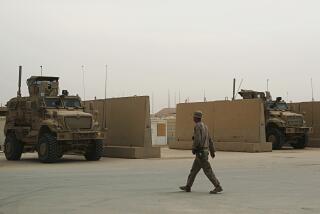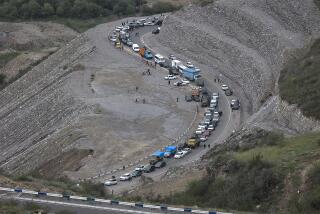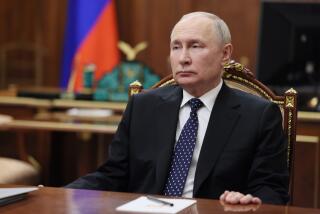BALKAN PEACE TREATY : Policing the Peace
- Share via
The peace deal signed Thursday formally ends the 3 1/2-year-old war in Bosnia-Herzegovina, setting in motion the deployment of NATO-led soldiers, including 20,0000 Americans. Under the agreement, the country will be split roughly in half between the warring factions. The pact also calls for a loosely centralized government, the return of refugees to their homes and free elections to be held within nine months.
NATO OBJECTIVE
The NATO-led troops will enforce a peace, not fight a war. Their first task is to see that the warring factions move behind the new territorial lines. Once this is done, they will monitor and patrol a buffer zone to keep the two sides apart. The NATO-led forces will not be involved in reconstruction, humanitarian relief or human rights efforts. Civilian organizations will be responsible for these tasks.
TIMETABLE
Dec. 14: Peace accord signed in Paris.
Dec. 14-15: U.N. Security Council to pass a resolution authorizing allied military operation in Bosnia and placing NATO in charge.
Dec. 15: President Clinton formally orders U.S. troops in. First elements of main 20,000-member force begin arriving. Warring factions begin withdrawing their forces from the zones of separation, marking boundaries and removing mines.
Dec. 17: Air-defense radars shut down.
Dec. 18: Arms reduction talks held for warring factions.
Jan. 15, 1996: Foreign troops and mercenaries due out of Bosnia.
Feb. 15: 60,000-member NATO-led peacekeeping force completes its entry into Bosnia.
April 15: Warring factions to complete the withdrawal of all heavy weapons and forces to barracks areas.
June 15: Warring factions to complete negotiations on arms limits
Sept. 15: NATO-led forces begin gradual withdrawal.
Dec. 15: Troops complete their withdrawal.
NATO CHAIN OF COMMAND
Under Smith, there are three component commanders:
1. British Army Lt. Gen. Mike Walker, commander of the ground troops assigned to Bosnia.
2. U.S. Air Force Lt. Gen. Mike Ryan, commander of the NATO air operations
3. Italian Adm. Mario Angeli, commander of NATO naval operations in the area.
U.S. CONTINGENT
20,000 in Bosnia
5,000 in other parts of former Yugoslav federation
3,000 as support from outside region
9,000 participating at sea and in air cover
37,000 TOTAL (13,000 from U.S. 1st Armored Division based in Germany)
U.S. ARMOR INCLUDES:
150 M1A1 tanks
250 Bradley fighting vehicles
50 Apache attack helicopters
CONTRIBUTING COUNTRIES
NATO countries:
Belgium
Britain
Canada
Denmark
France
Germany
Greece
Italy
Luxembourg
Netherlands
Norway
Portugal
Spain
Turkey
United States
Non-NATO countries:
Austria
Bangladesh
Czech Republic
Egypt
Estonia
Finland
Hungary
Latvia
Lithuania
Malaysia
New Zealand
Pakistan
Poland
Russia
Slovakia
Seden
Ukraine
PATROLLING THE BUFFER ZONE
Each of the three sector leaders--Britain, France and the U.S.--will set up patrols, made up of their own and allied troops. They will also rely on:
Personnel carrier
Surveillance drones
Satellite images
Ground sensors (small rods that can be disguised to look like a tree or a rock. They pick up motion by detecting changes in acoustics or heat.)
Air reconnaissance
Troop patrols
Researched by ART PINE and MATT MOODY / Los Angeles Times
More to Read
Sign up for Essential California
The most important California stories and recommendations in your inbox every morning.
You may occasionally receive promotional content from the Los Angeles Times.










